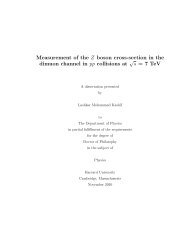2 The CDF Experiment at Fermilab Contents - Harvard University ...
2 The CDF Experiment at Fermilab Contents - Harvard University ...
2 The CDF Experiment at Fermilab Contents - Harvard University ...
Create successful ePaper yourself
Turn your PDF publications into a flip-book with our unique Google optimized e-Paper software.
Section 2: Central Muon Extension 31<br />
\wedgelets" which cover 5 each. <strong>The</strong>se chambers will lie in a plane tilted 30 with respect<br />
to the vertical. In all respects their performance should be the same as the rest of the<br />
CMX system. In particular, the preampliers are the same as are the ASD's and TDC's.<br />
By design the trigger will not distinguish between the arches and the miniskirt; they must<br />
appear to be part of one homogeneous detector.<br />
<strong>The</strong> miniskirt wedgelets must be supported on a stand. Unfortun<strong>at</strong>ely, the original plans<br />
will not work, and so a complete redesign is in progress. <strong>The</strong> main constraints come from the<br />
access required by other detector systems, including the CMP and the central calorimeter.<br />
<strong>The</strong> new stand must allow access for quick repairs during the run, which makes its design<br />
challenging. Moreover, allowance has to be made for thick cooling w<strong>at</strong>er pipes servicing the<br />
silicon vertex detector.<br />
This Summer one quadrant of the miniskirt will be assembled <strong>at</strong> <strong>Fermilab</strong>. After uncovering<br />
the diculties of assembly, we will produce the remaining quadrants in order to be<br />
ready for install<strong>at</strong>ion in 2000.<br />
With the CMX complete, the increase in d<strong>at</strong>a potentially is quite large. Taking inclusive<br />
W 's as an example, the CMUP+CMX sample is 57% larger than the CMUP sample. Plugging<br />
the gaps in coverage amounts to an increase of 11% for central muons (jj < 1), and<br />
leaves only 6.9% uncovered.<br />
<strong>The</strong> CMX arches functioned well in the last run, as far as identifying muons is concerned.<br />
<strong>The</strong>re were major diculties with the CMX trigger, however. <strong>The</strong> basic problem was exposure<br />
to soft particles sc<strong>at</strong>tered <strong>at</strong> large angles from the beam pipe and the forward detector<br />
systems. Since the calorimetry did not shield the CMX from particles coming from the forward<br />
direction (opposite to the interaction region), triggers from true muons were swamped<br />
by fake triggers. Several measures were introduced to ght this problem. First, the beam<br />
pipe was made thinner. Second, some activity in the hadron calorimeter indic<strong>at</strong>ive of a<br />
through-going minimum-ionizing particle was required. Finally, the timing inform<strong>at</strong>ion from<br />
the scintill<strong>at</strong>ors was fully exploited, to dierenti<strong>at</strong>e between the time required for a muon to<br />
reach the CMX from the interaction point and the time required for the fast particles from<br />
the interaction point to hit the forward detectors and sc<strong>at</strong>ter debris back upinto the CMX.<br />
Despite these eorts, the r<strong>at</strong>e for the inclusive CMX muon trigger was till too high.<br />
A fraction of the d<strong>at</strong>a, adjusted according to the instantaneous luminosity, was discarded<br />
online, in order to not exceed the trigger bandwidth. This so-called \dynamical prescaling"<br />
strongly reduced the collected d<strong>at</strong>a; we want to elimin<strong>at</strong>e the need of dynamical prescaling















